Minion 35
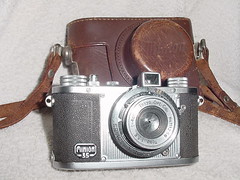
|
| Picture courtesy of eBayer vntt67. (Image rights) |
The Minion 35 is a series of 35mm viewfinder cameras, made by Tōkyō Kōgaku (later Topcon) between 1948 and 1953. It was the first series of 35mm cameras made by the company, that had previously made a series of 4×5cm folders also called Minion (see the corresponding page). The main designer of the Minion 35 was Otagi Michifusa, who had also designed the previous Minion.[1]
Contents
General description
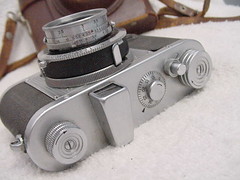  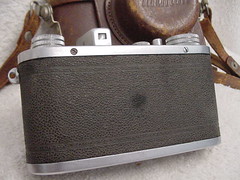
|
| Minion 35B no.111273, Toko 4cm f/3.5 lens no.111256. Pictures courtesy of eBayer vntt67. (Image rights) |
All the Minion 35 models have the same round-edged body, with strap lugs at both ends. The top plate supports the tubular viewfinder, offset to the left, the advance knob at the right end and the rewind knob at the left end. There is an exposure counter to the right of the viewfinder.
A rectangular metal plate, showing a pattern of vertical slots, is screwed to the front of the body and surrounds the lens and shutter assembly. There is also a MINION 35 nameplate attached to the front of the body.
 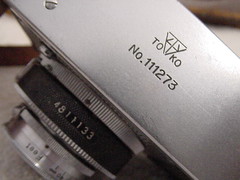
|
| Bottom plate open for film loading, and displaying the logo and serial number. Pictures courtesy of eBayer vntt67. (Image rights) |
The back does not open and the film is loaded through the bottom. The bottom plate is similar to the baseplate of the Leica screw models. It has the serial number and the TOKO logo of Tōkyō Kōgaku.
All the models have a Seikosha-Rapid shutter, giving B, 1–500 speeds. The shutter plate is marked TOKYO OPT. CO. at the top and the speed rim is engraved SEIKOSHA–RAPID at the bottom. The shutter is synchronized for flash and a hole is visible in the front rectangular plate, near the bottom, that is probably the synch post.
All the models have a Toko 4cm f/3.5 lens made by Tōkyō Kōgaku, said to have three elements.[2] It seems that the lens can be unscrewed, but only the standard lens was available.[3]
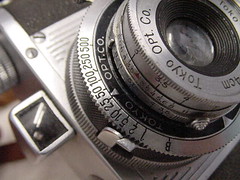 
|
| Toko 4cm f/3.5 lens no.111256, Seikosha-Rapid shutter. Pictures courtesy of eBayer vntt67. (Image rights) |
The Minion 35A
The Minion 35A, also called Minion 35 in short, takes 40 exposures in 24×32mm format and has no body release: the release lever is directly placed on the shutter housing. The advance knob is only used to wind the film and the shutter is separately cocked by another lever. There is a button above the top plate, similar to the body release of the later models but smaller, used to unlock the film advance after each exposure.
This model was featured in Japanese camera magazines dated 1948 and 1949, under the name Minion 35A or simply Minion 35.[4]
The Minion 35B
The Minion 35B also takes 24×32mm exposures but it has a body release. The release button is larger than the advance unlock button of the Minion 35A and it is similarly placed. The connecting rod between the body release and the shutter is visible above the shutter housing. The body release simultaneously unlocks the film advance and the camera thus has double exposure prevention.
This model was featured in Japanese magazines dated 1949.[5] Kokusan kamera no rekishi also mentions an article published in the October 1948 issue of Ars Camera, describing a Minion 35 II, apparently the original name of the Minion 35B. (The camera is mentioned as having an interchangeable lens.)[6]
The Minion 35C
The Minion 35C takes 24×36mm exposures and is otherwise similar to the 35B. It seems that all the examples of the 35C and some late examples of the 35B have a coated lens, indicated by various markings: in chronological order they are the word Toko written in red, a red C before Toko and a red C between 1:3.5 and f=4cm.[7]
The only way to externally distinguish the 35B and 35C is to look at the exposure counter. It seems that the 35C has a higher exposure counter while it is lower on the 35B.[8]
The Minion 35C was featured in Japanese magazines dated 1951, but it was probably released earlier, perhaps in 1949.[9]
The Minion 35E
The Minion 35E was featured in the February 1953 issue of Ars Camera. It was announced as a completely revamped Minion 35, with the shutter cocking coupled to the film advance, an interchangeable Toko 40/3.5 lens and a Copal shutter giving B, 1–200 speeds. This description corresponds to the Topcon 35A except for the shutter's top speed.[10]
No Minion 35D is known.
Notes
- ↑ Fujishima, p.89 of Kurashikku Kamera Senka no.4.
- ↑ Three elements: Antonetto and Russo, p.27, and other sources.
- ↑ Lewis, p.63. See also this page at Nekosan's website (archived), mentioning that the screw thread of the Topcon 35 lens is the same as for the Minion 35.
- ↑ Kokusan kamera no rekishi, p.368.
- ↑ Kokusan kamera no rekishi, p.368.
- ↑ Kokusan kamera no rekishi, p.368.
- ↑ First style visible in this page of the Topcon Club website. Second style visible in this page of Nekosan's website (archived). Third style visible in McKeown, p.924 and observed in an online auction.
- ↑ This is apparent from the pictures of Nekosan's page`(archived). The pictures of Sugiyama items 3418 and 3419 show the reverse, but they were possibly swapped: item 3419 has the earlier lens n°111433 and is perhaps a 35B whereas item 3418 has the later lens n°112564, with Toko written in a different colour (surely red), and is perhaps a 35C. It is also possible that the camera presented in Antonetto and Russo, p.27, is a 35B and not a 35C.
- ↑ Magazines dated 1951: Kokusan kamera no rekishi, p.368. 1949 release date: Antonetto and Russo, p.27; Sugiyama, item 3419.
- ↑ All the paragraph: Kokusan kamera no rekishi, p.368.
Bibliography
- Antonetto, M. and Russo, C. Topcon Story. Lugano: Nassa Watch Gallery, 1997. ISBN 88-87161-00-3. Pp.27–8.
- Asahi Camera (アサヒカメラ) editorial staff. Shōwa 10–40nen kōkoku ni miru kokusan kamera no rekishi (昭和10–40年広告にみる国産カメラの歴史, Japanese camera history as seen in advertisements, 1935–1965). Tokyo: Asahi Shinbunsha, 1994. ISBN 4-02-330312-7. Items 906–11. (This source does not reproduce any advertisement for the Minion 35.)
- Fujishima Kōichi (藤島広一). "Meiki no sekkeisha" (名機の設計者, Designers of famous cameras). Kamera Rebyū: Kurashikku Kamera Senka (カメラレビュー クラシックカメラ専科) / Camera Review: All about Historical Cameras no.4, March 1984. No ISBN number. Meiki no keifu (名機の系譜, special issue on famous camera families). Pp.86–90.
- Lewis, Gordon, ed. The History of the Japanese Camera. Rochester, N.Y.: George Eastman House, International Museum of Photography & Film, 1991. ISBN 0-935398-17-1 (paper), 0-935398-16-3 (hard). Pp.62–3.
- McKeown, James M. and Joan C. McKeown's Price Guide to Antique and Classic Cameras, 12th Edition, 2005-2006. USA, Centennial Photo Service, 2004. ISBN 0-931838-40-1 (hardcover). ISBN 0-931838-41-X (softcover). P.924.
- "Shirarezaru kamera: Minion 35C" (知られざるカメラ・ミニヨン35C, "Unknown cameras: Minion 35C"). Kamera Rebyū: Kurashikku Kamera Senka (カメラレビュー クラシックカメラ専科) / Camera Review: All about Historical Cameras no. 11, March 1988. Tokyo: Asahi Sonorama. (Never seen but the title is given by this page at Kanroshobo.)
- Sugiyama, Kōichi (杉山浩一); Naoi, Hiroaki (直井浩明); Bullock, John R. The Collector's Guide to Japanese Cameras. 国産カメラ図鑑 (Kokusan kamera zukan). Tokyo: Asahi Sonorama, 1985. ISBN 4-257-03187-5. Items 3417–9.
Links
In English:
- Pages of Nekosan's site (archived):
- Tōkyō Kogaku viewfinder and rangefinder models (archived)
- Minion 35 (archived)
- Minion 35A (archived)
- Other Tōkyō Kogaku viewfinder and rangefinder page (archived)
- First postwar leaf-shutter cameras (archived)
- Past sales by Westlicht Photographica Auction:
- Minion 35A serial no. 110316: lot no.645 of auction no.4 (November 22, 2003)
- Minion 35C serial no. 111922: lot no.646 of auction no.4 (November 22, 2003)
In Japanese: